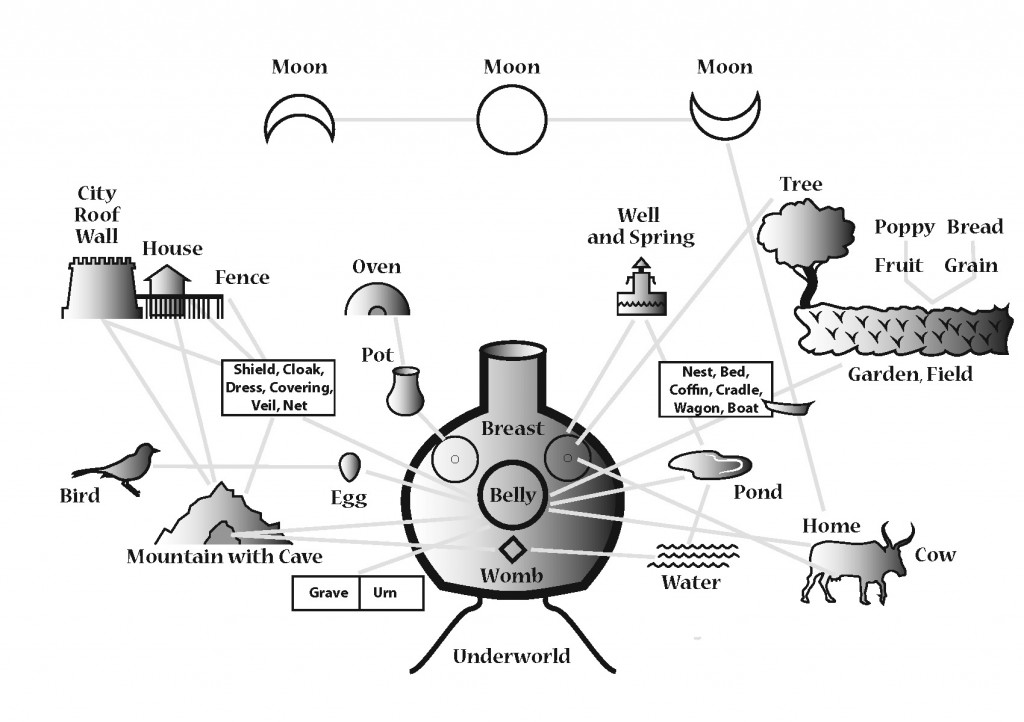Jo Matsen began creating her Mythic Image series in 1986, after a number of years of reading and study of ancient art and mythology. She was looking for a way to create a meaningful and original body of work, while remaining close to the ancient images she loved. Readings in The Gate of Horn (Levy) and The Masks of God (Campbell) [1] had shown that certain elements tended to recur in many cultures and times. One particular group consisted of a woman, the mountain, the cave within the mountain, the moon, cows, birds, water and burial (often in the cave).
Overview
The series of earth mother paintings arose from an appreciation of ancient artifacts from a wide range of cultures, and continuing in their significance to the present day. A regularly appearing group of motifs found in a wide range of cultures stretching from Africa to Europe and as far as India created the master design for each of the paintings. Central to each is the mother as the earth itself, often as a mountain containing a cave. This cave is both the womb of the earth and the tomb of the dead, who return to the earth to become the source of the next generations of life, an idea which continues today in our work to recycle and to compost.
This mountain image can take many forms- any container or vessel can be a version of the earth with its inside as the source of new life as well as a final resting place for the dead. We cannot survive without continual new life coming from the earth- that new life is our food, and we rely on the earth/our mother to provide it and to feed us. The earth does this through providing animals for us to eat and in being the soil from which food plants sprout. Its/Her waters, coming from inside her like a mother’s milk, nourish the plants and animals on which we depend. These food animals, whether sources for meat or for milk, are often horned or antlered; deer, cows, sheep and goats. These horns resemble the horns of the moon as it goes through its monthly transformation, which was recognized very early as having a close association with women’s monthly cycles, thus reinforcing the grouping of moon, food animals and the female.
As cultures became more developed, each of these basic motifs acquired new expressions. The cave could become a tomb, an urn for ashes, or the underworld. The mountain/earth could become a jar, a house, an egg, a pyramid tomb, or a female figure. Water could be milk or birth fluid. The animal expressions of the earth, in addition to the horned food animals, were water birds (sharing the spaces of earth, sea and sky, as well as layers of eggs) and the creatures of the waters (swimming into being in the birth fluids of the earth).
Each of these paintings shares a common design and structure. In the center is the mountain/female/vessel- the earth as mother. In each case she is giving birth to the life which will nourish people on earth, and feeding this life with her milk. The horned animals and the moon are her gifts and symbols. Her internal space is her womb and also the final resting place for the dead. Humans perform rituals to remind them of their relationship to the earth and to reinforce their bonds with her.
While many choose to see this earth mother as a goddess, that has not been the object of this series. The earth’s natural processes are miraculous enough to ensure continuing life without the need for any further magical or supernatural powers.
Fundamental to the development of this project were readings in The Gate of Horn by Rachel Levy, The Great Mother by Erich Neumann, The Masks of God by Joseph Campbell, The Silbury Treasure by Michael Dames, The Mycenaean Tree and Pillar Cult by Sir Arthur Evans, The Goddesses and Gods of Old Europe by Marija Gimbutas, Prolegomena to the Study of Greek Religion and Themis by Jane Harrison, and Seal Cylinders of Western Asia by William Ward. As the project was nearing its end, The Myth of the Goddess by Anne Baring and Jules Cashford was published, which collected much of the material used in the project in a comprehensive way.


Pingback: Welcome! | My Blog